Heath Rezabek is concerned with information — how we uncover it, how we use it, how we store it against cataclysmic events. A librarian and futurist, Heath uses science fiction to explore how Vessels of preserved knowledge might be developed and maintained not only on Earth but in the far reaches of our Solar System and beyond. In today’s work, he traces resource discovery and archival technologies back as far as Vannevar Bush and forward into a future that has transformed our early experiments into endlessly morphing realms of human growth and preservation.
by Heath Rezabek

This is the fourth installment in a continuing series of speculative fiction here on Centauri Dreams. Feedback from prior installments helps shape the themes and direction of subsequent entries, but the purpose and focus of these pieces is to explore a timeline (or timelines) in which comprehensive, resilient archives of Earth’s biological, scientific, and cultural record — deep archives for deep time — are developed through unexpected means.
Woven Light (I) – Vessel Haven https://centauri-dreams.org/?p=29669
Woven Light (II) – Adamantine https://centauri-dreams.org/?p=29897
Woven Light (III) – Augmented Dreamstate https://centauri-dreams.org/?p=30128
Woven Light (IV) – Proteaa
– – – –
Buckminster Fuller, in the process of designing and inventing a variety of structures based on geodesics, was at one point challenged by a patron to design a city which could float in Tokyo Bay. While this seems similar enough to the modern concept of seasteading, Fuller decided that the challenge was lacking in ambition. He instead developed a hypothetical framework for truly floating cities: Spherical structures which could drift above the surface of the Earth, configured internally however one wished.
Fuller believed such structures would not likely be built until pressures on Earth’s resources and settlement sustainability were much greater than they were at the time, and he somewhat whimsically called them Spherical Tensegrity Atmospheric Research Stations (STARS), or Cloud 9s. They were based upon the simple fact that if one enclosed a half mile (diameter) with a geodesic sphere, the structure itself would weigh but a thousandth of the weight of the internal air. Thus, if heated by a degree or more, the structure would lift and could become airborne.
Only glimpsed and hinted at here, we may see them again in future installments. As fantastical as they may seem, they bear a striking resemblance to an even more astounding thought experiment, also explored here.
Freeman Dyson, in his session for 2013’s Starship Century Symposium, proposed one of the most startling instances of a Vessel-like archive in my ongoing survey of such proposals: Called “Noah’s Ark Eggs” – I often refer to them as Dyson Eggs for short – their collections would be living biospheres, each self-contained and independent as a carrier of Earth-originating life to distances as far as you could wish, as randomly as you please. In this scenario, careful construction and glazing – aided by the engineering of viparious plants – would allow a Dyson Egg to contain enough heat to sustain a biome on starlight alone, as it drifted or was directed through the chilly reaches of space.
As living archive, each instance would develop by natural selection from a single-set in countless directions, ultimately carrying those finely honed living ingredients and blueprints to unknown worlds like dandelion wisps on the wind. This idea was mentioned in a prior Vessel Open Framework entry, discussing the possibility of individual habitats throughout the asteroid belt as a way to mitigate Xrisk.
If Dyson Eggs could be engineered for human (or transhuman, or posthuman) purposes as well as those of plant life, another unknown avenue for Earth-originating archives and civilization would open up. We also ask: if in space Dyson Eggs are possible, then are Fuller Spheres / STARS / Cloud 9s possible as well, above the surface of the Earth or elsewhere? If not as extended-purpose habitats, might our fictional version of Vessel Labs give them a try, for limited-population Vessel archives, in a timeline yet to be explored?
Although discussed most fully in the course of the narrative, one last design fiction is to be mentioned here as well, and that is Vannevar Bush’s Memex, as detailed in his 1945 Atlantic article, As We May Think. His original proposal has much more in common with nascent augmented intelligence than it does with what we now have at hand in our current digital networks; that original article is always worth a new look as we weigh our future aspirations against the technologies envisioned by our predecessors.
– – – – –
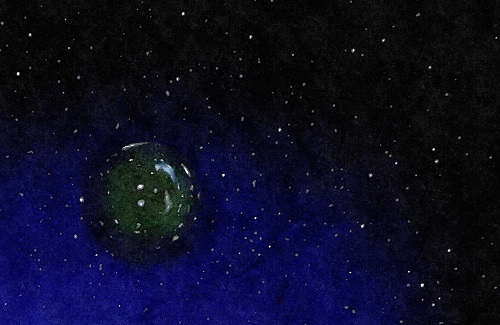
Image: ‘Precursorae’, Heath Rezabek. Adaptation of photography CC BY-SA Wikimedia.
Shimmering, barely a flicker against the wall of night, a slim circumference slides stars aside at its edges, falling through the space between.
Inside thrives a verdant darkling jungle, weightless and entangled. Structurally, its mass is a mesh of entwined greenery, countless conduits, endlessly connecting.
Its warmth is fed by the barest of starlight; its mission knows no fixed end.
Amidst the brambles, prowlers make their slow way from one kill to the next, as the smaller ones scurry between safer perches, instinctually, perpetually, all one in their motion.
At a glance, the apex is red in tooth and claw. But appearances can deceive, in light as lost as this shadowing. The true apex belongs to beings who’ve smoothed their subtler instincts until they’ve fused with logic and language alike. Were there a way for us to witness them, grappling and gliding between boughs, we would be excused for mistaking them as human. Yet human — strictly speaking — the Avaai are not.
The name is emergent and generative, like their language. It means, more or less, “Those who remain through departing.” They are, in some ways, our descendants; but in timeless reaches, their science reborn as generative myth, even they will come to be known as precursors. And they are few among many, splayed afield and bound far from their fellows by a gambit: a seed, a sphere, an impossible Aleph.
Of the many names given to these starborne terraria in the deeps of their time, Precursorae was one. Ark Ovae another. Dysonae, a third. They are adrift; but they are never alone.
The Avaai have two eyes and ears, yet they share thought with myriad nearby forms who have nothing of the sort. The Avaai have two legs and two arms, yet their movements are lithe and their forms are stretched by weightless dance. Their features are more angular, their aspect more severe; their thoughts a fog of mind shared with all around them. They are organic, but they are not, so to speak, biological. They are synthetic, but they are not, as it were, artificial. Like koans, like the Tao, they are better described through what they are not.
They are Proteaa, and like everything else here, they share a basis in Protean cells.
Like Protean cells themselves, the Avaai are transmortal, able to pass from one form into another, able to share their thoughts and lives with the flora and fauna all around them, with which they are inextricably bound.
The fog of mind is their medium; fluid sometimes, particulate at others. They craft artifacts, in which every atom carries an echo of the whole. They are solid state; yes, and liquid as well.
But one thing they do not know, collectively or alone, (for they can recede and retreat if they wish) is how long they have been, and how long they might be. The deep well of remembrance harbors a mythology which has mapped the slow drifting of their constellations into shapes entirely other than the ones they’d known before.
These ever changing all-surrounding starfields — the personae retraced upon them — are their mythemes, the most basic of forms. Formulae and hypotheses, a scattered suspension of salt in the waters. ~For matter is slumbering light~
Their inheritance is a deep-healing habit of retreat, where solitude and union cleave and renew. And when they look closely, turning inwards, they can gaze into a place that is also time. They can convene and converse with a dark mind made clear through its gravity, known to them as the Kainadhren, Ancient Light. And through its channels and conduits, they can quite nearly reach other times and far places. Quite nearly: pushing at that membrane which reflects all times and places, an infinity-etched horizon.
We would find life within a Protean Precursorae to be brief and delirious. But we can guess in some sense at the transmutable lives of the Avaai, because we were the ones who observed the emergence of the Proteaa. And together, we’ve run the simulations.
– – – – –
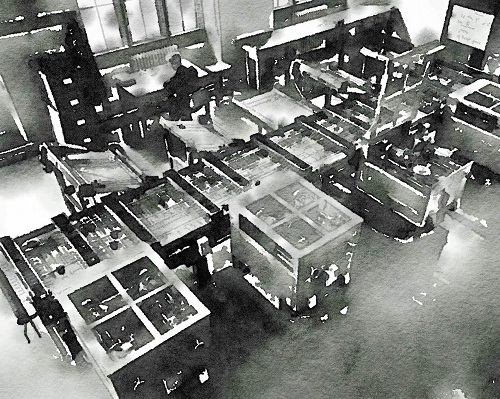
Image: Adaptation of ‘Vannevar Bush’ CC BY-SA Wikimedia.
Before Thea Ramer was a research scientist in holographic cartography, she was a writer of speculative fiction, part of a writing group with several instances around the world. As part of this club, she’d developed a series of writing exercises to banish forever the excuse of writer’s block. One of her inspirations in this had been a now-mythic proposal by a wartime scientist named Vannevar Bush, titled As We May Think.
Although history would see this work as having been a key inspiration in the development of her era’s still-capitalized Internet, the original proposal had much more to do with memory and association than it did with switching or even linking. His thought-experiment prototype, which he called aMemex, was to be a way for thinkers to track and trace the sinuous pathways of their own inspirations and memories, as they sparked and resparked one-another, clustering and growing over time.
For Vannevar Bush, tasked with assisting in the collective remembrance of a generation of scientists at work in dark days, this was a way for thinkers to organically archive and pass down their best associations and kernels of discovery. But Thea saw something different in the latent potential of Bush’s original model. “Writing is a way of thinking in traces,” she would say; and she had glimpsed a means for regenerating a primordial soup of ideas through association, whether done alone or as a game between players. And so a set of writing (which is thinking) exercises emerged.
The exercises could be used by anyone with a challenge to overcome; and indeed, she herself would apply these methods much later in her work on holographic syntax, which would eventually yield hologlyphs, which would come to find a home deep down in the living code of Protean cells.
At the time of her efforts on her speculative fiction, The Tracer Guild, her use of these tools were in full swing. Though it would be years before they were adapted for work on the Avatamsaka synthetic mind, already she’d called the resulting pool a Codex – partly in honor of the Memex, and partly from an understanding that before there were books, there were bundles bound by hand and over time. To Thea, a Codex was bound not by thread but by association, theme, subject, intent.
Any given project might have a codex built up around it, filled with its influences and fragments of its form. In this way, a codex became a kind of random access archive of materials and raw ingredients, in which orderly arrangement was much less important than withdrawing sets and samples in a way that sparked sensemaking. In its earliest forms, the Vessel Codex which would ultimately drive Avatamsaka’s pattern-sampling technique was initially a very manual approach.
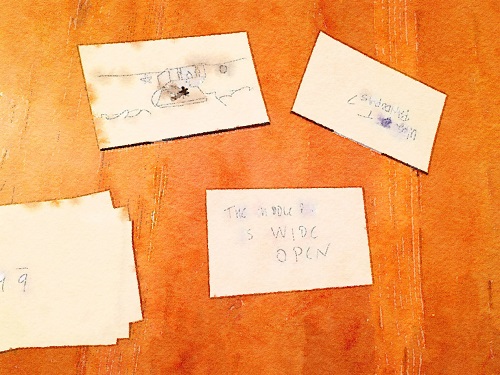
Image: ‘Wildcards.’ CC BY-SA Heath Rezabek.
Wildcards worked like this: You needed at least three players, each with a stack of blank index cards. The seeker (whose turn it was) would write on a blank (or draw if need be) something on their minds, on which they were seeking input. They’d lay it out, and the others would pen their response, based on what they knew of the seeker and the subject. The seeker would take stock, and pick the most useful response. They’d get to keep all the cards as payoff, and the turn would pass to the one with the favorite response, who’d get to be seeker in turn. The mechanic wasn’t perfect, and they were always tweaking it; but this was its basis.
Though it’d be tedious to detail the turns of their session here, it’s worth noting that this evening Thea walked away with five cards whose contents would come to influence her work more than she could have guessed.
[ Pathfinders ]
[ Shadow-forms gather around the core ]
[ The riverbed splits at a massive, ancient tree ]
[ Albino traders make the best maps of the deeps ]
[ These passages go on forever ]
[ Ancient Light ]
She, in turn, had supplied these responses to her friends:
[ White dwarf stars ]
[ Rebuilt every twenty years ]
[ That which does not expand forever, eventually contracts ]
[ Tales of the Kami ]
[ All their constellations would differ from ours ]
[ Calligraphy, Astronomy, and Swordsmithing ]
[ Perhaps the solution is not chemical but mathematical ]
[ Customs are a form of Etiquette ]
Home again, Thea shuffled these cards into file with uncounted others. She had once spent her time typing them into an aging, soon to be extinct digital platform called HyperCard, the clack-clacking of her Centris a kind of hypnosis; but she’d come to trust both the durability and even the labor-intensity of her pen-scratched cardstock.
Thea Ramer surveyed the card files as she slid the last one into unsorted slumber. “There, now. Dream awhile,” she muttered, and reached for her wine. She would not draw any of these particular cards out in a pattern-sample for months — in several cases, she’d never lay eyes on them again. Yet there they lay and waited; a glimpse now and again was enough to plant seeds deeply in the imagination…
– – – – –
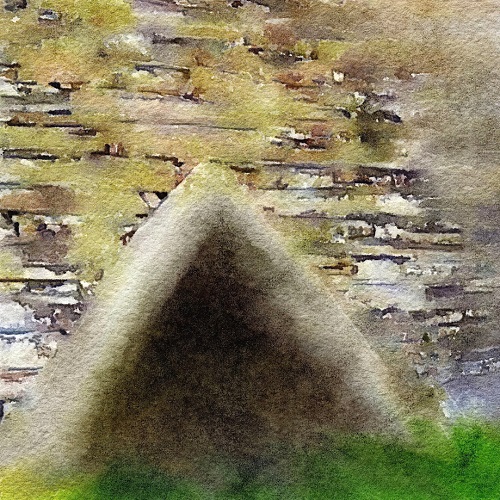
Image: Adaptation of photography CC BY-SA Wikimedia.
Dr. Kaasura stood, faltering in the low light of the cavern. Before him lay the crates, one — the white one he’d carried from the flooding road, splayed open, leaning on stone. He reached out, pulling it to rest level at his feet. The crate’s white material was dense, with a feel almost like sanded wood. Its matte sides, unscarred by the storm or his trials, reflected nothing of the cavern’s aqua glow. Jota wiped a stray leaf away, small bits of mangled fern sticking to his fingers.
Inside it was a very cubic looking box, quite black, also matte, and so featureless that, at this angle, it seemed to Jota’s eyes a dark hexagon, a gap in space, no edges to be seen.
A flicker skimmed the white inner surface of the crate. Kaasura walked closer, looking at the side wall, and found it lit with tiny squares of different hues. “Projections?” he muttered, looking back at the surface of the inner box. Pitch black, no signs of life. But another look at the projections was enough to resolve them clearly.
Arrayed against the white insides, countless little pinholes, neither square nor round, all different, faded in and out. Bringing his focus to bear on a small spot, Jota Kaasura could see a sea of impressions shimmer and fade: an iron teapot, or the image of one. His aunt, in a scene he could not recognize. Beside her, in another tiny scene, a small child bounced a ball, running in some game. A ruined landscape, scarred by a massive red orb, feral and fading… An apple; an overturned wheelbarrow; sunrise over a stormy sea. A slipstream sail gliding through depthless night.
Kaasura stumbled back, awestruck at the sight. Countless images, faded in and out as if clouds were passing in front of stars. He turned to face the wooden crate, then, as if to forget the black in white. It too looked identical to the one overturned by the truck, but its sides were dry, unmuddied, unbruised. Jota looked at the edges, and found them nailed shut. His fingers felt at his pockets, expecting the pocketknife they found there. He started prying at the lid, unsurprised when it released so easily from the crate. Unsurprised, but not untroubled.
Inside, old packing strips, shredded and brown; and nestled within – a kind of a globe. Several feet across, each tiny pane in its varied surface was triangular, miniature, geodesic. The glass was gritty, each edge a wiry seam. Jota braced himself to lift it — and failed. It was cold to the touch, even to his cold fingers.
Dr. Kaasura stood and sighed, turning to the metal crate. It seemed to have three latches, each with its own lock and perhaps with its own key. He was suddenly very tired.
“Who are you?”
Kaasura turned with a start. A woman stood in the far corner of the cavern, a staff turned towards him. He couldn’t make out her face, but she was short and her stance was strong. Jota held out one hand, open-palmed…
“Why are you here? How did you get here?” She took a half-step forwards, the end of her staff alight with countless fibres. Electrified?
He held up his other hand, nodding. “My name is Jota. I came here to shelter from the storm.” He gestured back to slick rockface behind him, the subsiding rains down below. “I… certainly didn’t expect to find anyone else here…”
She frowned at his nudge for information, hesitating before motioning towards the rear of the cavern. “I live here. Not here,” she motioned at the dim room around them, “back there; our skycity’s docked.”
She looked around then, almost nervously, as Kaasura considered what to say. She interrupted before he could.
“You can’t be here.”
“Why not?”
“It’s just not allowed. You have to be escorted.”
“Well, surely you could escort me, couldn’t you?”
“I don’t know you. I don’t know where you came from, or what your intent is, here.” She was on the edge of helping him; he could feel that much. He raised his hands higher, his arms wider, gesturing towards these ends.
“I only meant to shelter from the storm. I was fleeing for my life — well, that and… I was trying to save these crates.” He motioned, then, at the three mysteries tumbled on the floor.
She looked down at them, a worried look on her face. When she glimpsed the geodesic sphere in its shredded bed, she stopped short and her look turned strangely. “Where did you get that..?”
Eyes fixed upon the geodesic sphere, he watched her as he hesitated. She made her way towards the black box in its white crate. “What are they?”
“I’m not sure,” Kaasura said truly. “And without my laboratory, it’s hard for me to find out. I need a place to rest, and to work.”
She looked at him, long and low, weighing her factors.
“What is your name. I’m Jota. You..?”
Hesitation. Concern.
“… Call me Miira.”
He tried it: “Mirra?”
She shook her head, no longer so stern. “M i i r a”.
“Miira.”
She nodded — “Wait here.” — and turned.
A few steps towards a dark way he hadn’t seen, she paused. “That is, you’re free to go. Back the way you came. But don’t try to come after, until I return.”
Then in shadows, she was gone.
Jota blinked, hands still outstretched, the room suddenly vast in its silence. He walked towards the corner into which she’d disappeared, his eyes adjusting to the dim aquamarine light. Although there are fewer of the cracks he’d noticed on his way up the channel, he could still make out a few slim rivulets of mossy luminescence spreading out and down a smoothly carved tunnel, as if in glacial pursuit of Miira’s faded footfalls.
He stopped and examined the doorframe. Although the room of the cavern was roughly hewn, as if by nature and effort, at the rear a triangular bracing cut the wall, thick and apparently metal. The cavern that cut forth from there carried its angular lines, but split and bifurcated as it sliced through the stone.
He looked at the stone, then, as if for the first time. Pumice? Tiny dark cells in a petrified foam. He was exhausted.
Kaasura stepped backwards, once; twice; turning, he found support on the white crate, collapsing to the floor beside it, still soggy and cold.
Leaning his head against its sides, Jota sat facing the triangular passageway. He could hear dripping throughout the cavern, and far behind, the slow washing of sea and storm subsiding.
Echoes and stones, falling far in the distance, down the maze of twisty passages, along the way which Mirra had made her way, along the way…
And he begins to nod.
And he begins to dream.
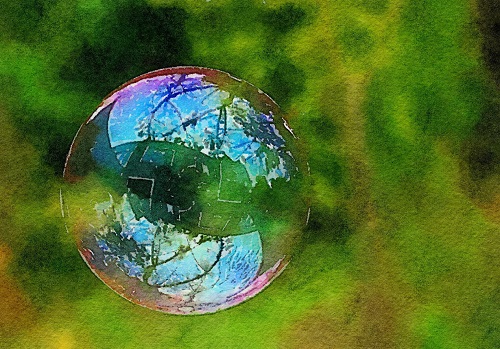
Image: Adaptation of ‘Reflection in a Soap Bubble.’ CC BY-SA Wikimedia.
And in the dream, Kaasura sees a bubble, adrift, floating high above the land. At first he thinks it’s a blown bubble, blown out over grass or a field. Its bright surface mirrors sharply the sky.
As he looks more closely, he can see features. The surface of bubble is riddled with layers and lines and portals and intaglio. There’s a texture to it, not quite consistent, but definitely patterned; definitely there.
Gigantic and ponderous, it drifts over the shoreline. He senses the scale, because far below he can see the ruins of the power plant. Smoke is rising from one of the crumpled generators. Steam billows as superheated runoff collides with the sea.
The sphere sails on, over the tips and tops of the mountain range (he can make out the cleft he climbed into) and on past the mountains. He follows as if in flight far above, freely falling through its wake. Below, mountain peaks cut coldly, impassably. It passes and passes them by.
The sphere reaches a wide open plain. As it opens up over that expanse, he can see that it’s a desert, cold and worn, under a ruddy sky. The ground has the strangest textures. Ancient and empty, crumpled and swept. Nothing breaks the surface of frozen red rock and rubble.
But in the distance, beyond the bubble by a far misty mile, he sees another. And then another; and he realizes that they’re getting smaller, as he rises higher.
More appear as they cluster and shrink beneath his altitude; they’re not near each other, but all of them drift as if part of the same current, eddying in waves as wide as landscapes, buoys and beacons on a sea of risen air. Signal lights flicker on their edges; warmer lights waver in their hearts.
And as Dr. Kaasura rises also, he begins to see an arcing curve to the land which lifts those bubbles, until they seem as if they’re afloat upon the surface of a bubble that’s far larger. And just as he feels the fragility can’t hold, he awakes — and finds he’s no longer in a cavern.
He takes a breath, and rubs his eyes. And far above his resting head, a skydome is traced, a prismatic array.



More please!!
I’m reminded of a conversation with a fellow grad student many moons ago … “When,” we complained, “will we get a textbook that does not start with Elementary X or Basic Principles in Y?” After so many years we felt we deserved books entitled ” Ultimate Knowledge in …” or “Advanced God consciousness”.
Silly I guess but our pile of knowledge keeps growing. How wonderful if we can transcend the transmission problem by establishing a “living” repository accessible to all with a … usb cable? or a Codex?
Thanks for the comment. I’m beginning to suspect that imagination, shaped and informed by the intellect, can help us access to more than we realize.
As for more, I recommend the prior installments, all linked in the intro! And of course, come back in a month or so…